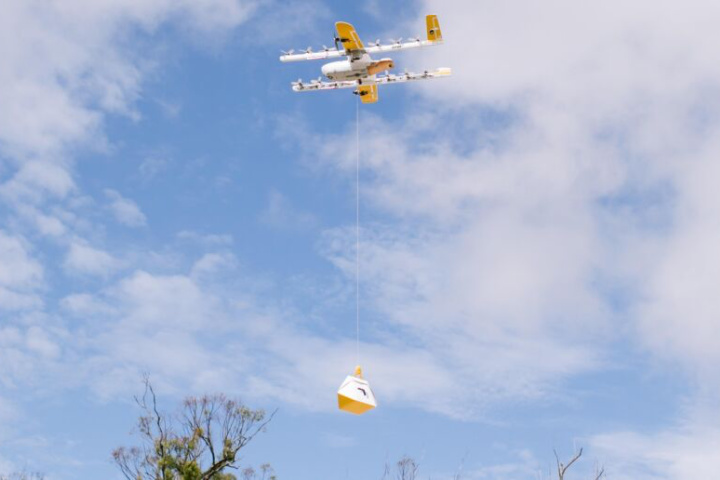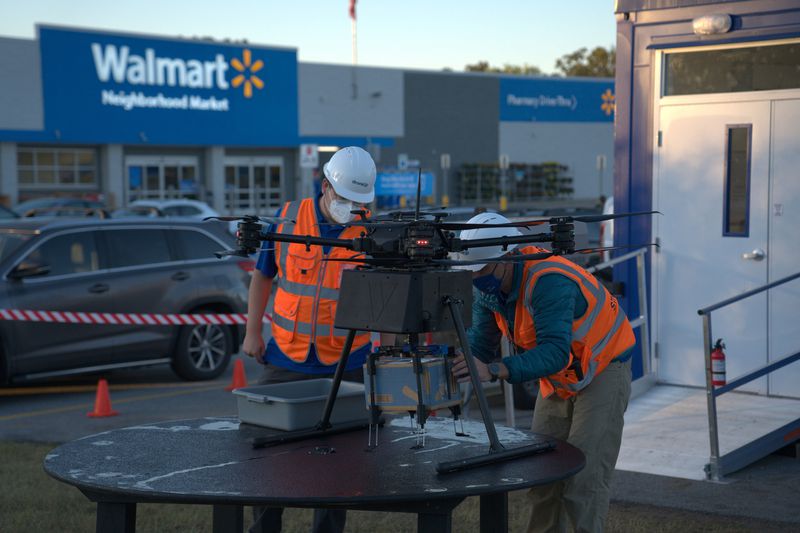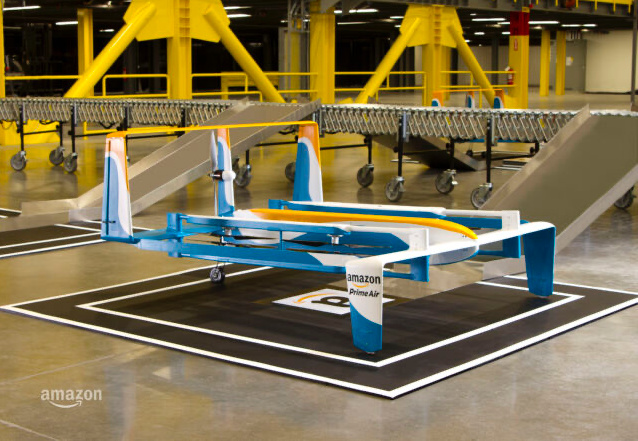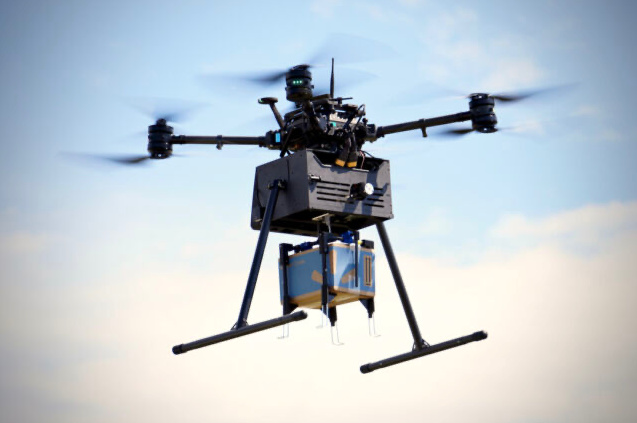From Arstechnica By TIMOTHY B. LEE
Drone delivery could be poised to take off in the United States.

A drone from Alphabet’s Wing delivers a package to a customer.
Earlier this month, Google’s sister company, Wing, began offering a drone delivery service in the Dallas suburbs of Frisco and Little Elm. Wing drones take off from “nests” in two Walgreens parking lots to deliver things like health products or ice cream to nearby customers. Wing describes it as “the first-ever commercial drone delivery service in a major US metropolitan area.”
One reason for that last caveat: Walmart has been running its own drone delivery service near its Bentonville, Arkansas, headquarters since November. Walmart delivers a range of products to customers within a 1.5-mile radius of two Walmart stores. The service will soon expand to a third Walmart store in the same corner of Arkansas.
Meanwhile, Amazon’s drone efforts got some unflattering press coverage last week. Bloomberg reported on a drone crash at an Amazon test facility in Oregon. No one was injured, but the story underscores the fact that Amazon has yet to launch a commercial drone delivery service in the United States—despite a December 2013 segment on 60 Minutes where Jeff Bezos predicted drone deliveries might reach the market in four to five years.
The Wing and Walmart services are still pretty limited, with each service initially designed to perform around 100 deliveries per day. But drone delivery is finally moving beyond the research-and-development phase. Wing and Walmart are using drones to deliver real merchandise to real customers. The question is how quickly they can scale up—and how many other companies can follow their lead.
Regulations are a major factor in the slow development of drone technology. The Federal Aviation Administration tightly controls every aspect of these services, requiring companies to get separate approval each time they expand to a new area. So the future of the industry depends a lot on whether the FAA promotes or hampers its growth.
How a startup built Walmart’s delivery service

For this story, Ars talked to Tom Walker, the founder, and CEO of the startup DroneUp, which supplies and operates Walmart’s delivery drones.
One of the most significant limitations the FAA imposes on drone operations is a requirement that they are conducted within view of a human operator. Companies can request a waiver of this requirement, but that’s a slow and difficult process.
So DroneUp has opted for a decidedly low-tech solution: constructing a miniature control tower, about 30 feet tall, in the parking lot of each Walmart. According to Walker, an operator in this control tower can see a drone as far as 1.5 miles (2.4 km) away. Walker hopes the FAA will eventually waive the line-of-sight requirement, allowing the company to utilize the full three-mile (5 km) range of its current drones to serve many more customers.

Tom Walker, CEO DroneUp
That isn’t to say the whole operation is low-tech. Far from it, according to Walker, who says the drones are “fully autonomous.”
FAA regulations prohibit a drone from flying over people or moving vehicles. Walker says that DroneUp’s aircraft have “the ability to dynamically route around areas where [people and moving vehicles] might be, and also have sensors that let us know where people are on the ground.” The drones also have multiple redundancies to help ensure that the failure of any one component won’t cause it to crash.
The average delivery takes 27 minutes. Once a drone arrives at a customer location, a remote human operator uses cameras on the drone to verify that there is no one in the landing area. Customers are asked to keep themselves and their pets indoors until the drone flies off. The flight will abort if the operator sees anyone near the dropoff point.
If the coast is clear, the drone will lower a Walmart box using a cable from a height of around 80 feet. Once the package is safely on the ground, the drone flies away, and the customer can pick it up.
The company’s drones have eight propellers, and the service’s website says they can carry up to three pounds (1.4 kg) of cargo—though Walker says the drones are capable of carrying significantly more. For comparison, Wing’s service delivers up to 2.5 pounds of cargo. At the same time, DroneUp managed to keep the drone’s weight, with cargo, under 55 pounds (25 kg). That’s important because operating a drone over 55 pounds requires special permission from the FAA.
Walker hinted that he is expecting big growth for the Walmart service in the next year or two.
“I can’t say how many [stores] we’re going to be opening this year or next year,” he told Ars. But he’s planning to grow the company from 200 to 600 people this year, with a substantial share of those new workers being drone operators.
Alphabet takes wing in Dallas
Wing is a product of X, the Alphabet “moon shot factory” that also produced the self-driving car company Waymo. Wing already has commercial services in operation in Australia, Finland, and a remote corner of Virginia. The company celebrated 200,000 total deliveries last month.
The new service in the Dallas area represents a significant expansion of Wing’s US footprint. And the company hinted that it has much larger ambitions.
“There are more than 7 million people who live in [the Dallas] metro area,” a Wing employee said in a recent video. “So when you think about the number of people we could serve just within this one metro area, it’s incredibly exciting.”
Unlike DroneUp, Wing has obtained an FAA waiver allowing it to fly beyond the visual line of sight. That allows Wing to offer deliveries as far as four miles away from a drone’s home base. Wing’s waiver also allows flights over people. This allows drones to pick up a new package by hovering about 23 feet (seven meters) in the air and extending a tether down to the ground.
Like DroneUp, Wing has its drones land and take off from the parking lots of its retail partners—in this case, Walgreens. Wing says that its landing sites, known as “nests,” need “just a few parking spaces’” worth of space. Inside the landing zone are charging pads with 2D barcodes to help the drones figure out where they’re supposed to land.
Wing says its drone is only 15 pounds (6.8 kg)—lighter than DroneUp’s delivery aircraft and (as we’ll see) Amazon’s prototypes.
Amazon’s failure to launch

A press image of Amazon’s drone from Amazon’s website. It’s not clear if this is what their current prototype looks like.
While Walmart and Wing have begun offering commercial drone delivery services, Amazon’s drones are still in the testing phase:
Bloomberg’s story prominently features Cheddi Skeete, a former employee of Amazon’s test facility in Pendleton, Oregon. I talked to Skeete for this story, and he connected me to two others who worked for Amazon in Pendleton. One of them shared Skeete’s view that Amazon wasn’t taking safety seriously enough, while the other had a more positive view of Amazon’s safety record.
Amazon defended its safety record in an emailed statement. “We use a closed, private facility to test our systems up to their limits and beyond. With rigorous testing like this, we expect these types of events to occur, and we apply the learnings from each flight towards improving safety. No one has ever been injured or harmed as a result of these flights.”
It’s not such a big deal if a drone crashes in an empty field. But it is likely to push back any plans to use the drone in more populated areas. It doesn’t seem like Amazon is on the cusp of commercializing its drone technology, even after nearly a decade of development.
An article in Wired last year described the turmoil in the UK branch of Amazon’s drone project. Amazon started testing delivery drones in the UK in 2016, but by 2021 people were telling Wired that the program was “‘collapsing inwards,’ ‘dysfunctional,’ and resembled ‘organized chaos’ run by managers that were ‘detached from reality.’”
One issue highlighted by Wired—and echoed in my conversation with former Amazon employees in Pendleton—was the size of Amazon’s drone. Wired said last year that Amazon’s drones had “ballooned to about 27 kilograms” (60 pounds). Two of the ex-Amazon employees I talked to agreed that the company’s drones were above the FAA’s 55-pound limit, requiring a special waiver.
Amazon has long set a goal to carry five pounds (2.3 kg) of cargo, which covers 85 percent of items for sale on Amazon. Making the drone bigger obviously helps with that. But the extra weight not only triggers extra regulatory headaches, it also makes everything else about the design more challenging. Larger drones are likely to be noisier, consume more power, and cause more damage if they crash.
Has red tape been holding drones back?

A DroneUp aircraft carries a Walmart package.
I think it’s interesting to compare and contrast the commercial drone industry with the nascent industry for self-driving cars. Over the last decade, both industries have developed more slowly than boosters expected. But the slow progress of self-driving cars has clearly not been the result of strict regulations.
Automotive safety regulations mainly focus on mandating the use of safety technologies like seatbelts, airbags, and antilock brakes. The law generally doesn’t require regulatory approval to add a new feature to cars because new technologies normally make cars safer, not less safe. As a result, companies developing self-driving technology have largely been free to do as they please.
The situation is very different in aviation. Anyone who wants to sell a new aircraft, start a new airline, become a pilot, or do anything else in the skies needs a license or other approval from the FAA. And to a large extent, the FAA has tried to shoehorn drones and drone operators into existing regulatory categories.
DroneUp CEO Tom Walker told Ars that in the early years, companies creating drone services were expected to comply with the same rules as commercial airlines. For example, early drone companies had to petition the FAA for a waiver of rules requiring all aircraft to have seatbelts.
New aircraft designs are supposed to go through a lengthy bureaucratic process called type certification.
“When you enter the type certification process you have to freeze your technology,” Walker told Ars. “Any significant configuration changes reset the process,” Walker says many companies thought they could obtain type certification for new drone designs in six to nine months. But some have been waiting for type certification for two years or more. Delays like that are particularly burdensome in the drone industry, where drone technology is still improving rapidly.
Another big sticking point is the rule requiring drones not to fly beyond their operator’s line of sight. DroneUp has pushed this requirement as far as possible by having operators work from elevated platforms 30 feet above the ground. But drone delivery services are ultimately going to need to travel farther than a human being can see.
To avoid being completely crushed by these kinds of regulations, drone companies have made heavy use of the FAA’s waiver process. That’s how Wing received permission to operate beyond the line of sight. But there’s no guarantee that the FAA will approve any given waiver request—or even respond to it in a timely fashion. And that makes it risky for a company—especially a startup—to develop new commercial drone technologies because an unfavorable regulatory decision could render years of research and development worthless.
Walker told Ars that the regulatory environment has been getting better in recent years.
“It really took the FAA getting serious and saying ‘this is a real thing, this drone fad isn’t going away,’” Walker said.
Last month, a federal advisory group issued new recommendations for standardizing and streamlining the rules for operating a drone beyond the line of sight. If the FAA acts on these recommendations, it should give companies working on commercial drones—for delivery or other purposes—a lot more clarity about what’s allowed and how long it will take to get the necessary approvals.
But I wonder how much the FAA’s slow-moving approach has held back drone innovation over the last decade. Some oversight is undoubtedly needed to make sure drones don’t fall from the sky and injure or kill people. But with better rules and more responsive regulators, I suspect we’d have a lot more than two companies rolling out drone delivery services right now.
Tim Lee was on staff at Ars from 2017 to 2021. In 2021, he launched Full Stack Economics, an independent email newsletter about the economy, technology, and public policy. You can subscribe to his newsletter here.






